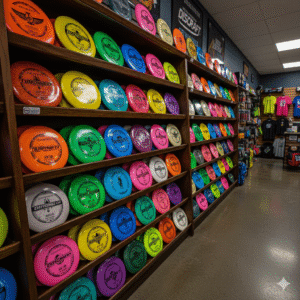Ever dream of launching booming drives that leave your friends in the dust? Struggling with wobbly throws that barely escape the tee pad? The secret to unlocking consistent distance and control might be hiding in plain sight – disc golf driver weight. This often-overlooked factor can significantly impact your throws, and concentrating on it can transform your disc golf experience. Let’s delve into the fascinating world of disc weight, exploring how it affects flight patterns, optimizing your game for different conditions, and ultimately, helping you dial in those drives for disc golf glory!
Listen up, fairway crushers! We’ve all been there – staring down a long hole, the perfect line in mind, only to unleash a wobbly drive that barely leaves the tee pad. Frustrating, right? But what if I told you a simple tweak to your driver selection could unlock hidden depths in your game?
That’s the power of disc weight, folks. It might seem like a minor detail, but trust me, understanding how weight impacts your throws can be a game-changer. Let’s dive deep and explore how to leverage this often-overlooked factor to elevate your disc golf experience.
How Does Disc Weight Affect Your Game?
Imagine a disc as a tiny airplane. Lighter discs, like those pesky 150 grams, have less mass and are more susceptible to wind gusts, acting like a feather in a hurricane. Heavier discs, on the other hand, are more stable, battling wind like a seasoned pilot.
This translates to flight patterns. Lighter discs generally travel further with less power, making them ideal for beginners or tailwind situations (or old-timers like me!). However, they can be flippy and unpredictable in a headwind. Heavier discs demand more muscle but offer superior wind resistance and a straighter flight path.
Weight also affects stability ratings. A heavier disc with a “7” stability rating might fly more predictably than a lighter disc with the same number. Think of it as the disc’s natural resistance to turning over.
Here’s a quick tip: When browsing discs, consider the manufacturer’s recommended weight range. This is a good starting point, but remember, it’s not set in stone!
Weathering the Storm: Weight and Different Conditions
Let’s talk about the elements. Cold weather can tighten up your muscles, reducing your throwing power. Lighter discs become your allies here, requiring less effort to achieve decent distance. However, be mindful of strong winds, which can wreak havoc on your lighter flyers.
Conversely, hot weather allows you to unleash your inner disc golf beast. Heavier discs become more manageable, offering added control and stability for those scorching summer rounds.
Remember, these are just general guidelines. Experimenting with different weights in various conditions is key to finding your perfect match.
Finding Your Sweet Spot: Choosing the Right Driver Weight
So, how do you pick the ideal driver weight? Well, it’s a beautiful blend of science and personal preference. Here are some factors to consider:
- Arm Speed: Do you have a powerful throw or a more finesse-oriented flick? Higher arm speeds benefit from heavier discs for better control. Slower arms might find lighter discs easier to handle.
- Playing Style: Are you a laser-focused bomber or a strategic course sculptor? Bombers often opt for heavier drivers for maximum distance. Control players might favour lighter options for finesse shots.
- Course Conditions: Is your local course a windy open field or a tightly wooded maze? Windy courses demand heavier discs, while wooded courses might benefit from lighter, more maneuverable options.
Don’t be afraid to experiment! Grab a buddy and head to a local field with a selection of drivers in different weights. Throw them side-by-side and feel the difference in stability, distance, and wind resistance. This hands-on approach is the best way to discover your personal sweet spot.
Demystifying Disc Weight: Science Behind the Spin
Alright, let’s get a little technical. Disc flight is governed by physics, and weight plays a crucial role. Here’s the gist:
- Inertia: Heavier discs have more inertia, meaning they resist changes in motion. This translates to a straighter flight path.
- Gyroscopic Precession: Imagine a spinning top. That’s the gyroscopic effect. Heavier discs maintain their spin axis better, leading to more stable flight.
Understanding these principles helps you appreciate the impact of weight on your throws. It’s not just about brute force; it’s about harnessing the physics of the disc to achieve optimal flight patterns.
Leveraging Weight for Disc Domination
Now that you’re armed with this knowledge, let’s explore some strategies to leverage weight for maximum impact:
- Maximizing Distance: If you crave those bombs, consider a heavier driver (within your arm speed limitations) for better control on powerful throws. Remember, clean technique goes a long way too!
- Conquering the Cold: Facing frigid temperatures? Lighter discs become your friends. They require less muscle to achieve decent distance, saving your precious energy for the course. Just be mindful of wind if it picks up.
- Taming Tailwinds: Tailwinds can be tricky. A lighter disc can actually travel too far, potentially sailing past the basket. Consider a slightly heavier driver (within your comfort zone) to maintain control and accuracy.
- Controlling Headwinds: Headwinds are the bane of many a disc golfer’s existence. Heavier discs are your shield, offering superior wind resistance and a more predictable flight path. Fight the urge to muscle up – focus on smooth, controlled throws.
Remember, there’s no one-size-fits-all approach. Experiment with different weights in various scenarios to build your disc golf arsenal. Here are some additional factors to consider:
- Disc Material: Premium plastics tend to be slightly heavier and offer more stability compared to base plastics. This might be a good option for players who want a heavier disc without sacrificing glide (the ability of a disc to stay aloft).
- Tournament Play: For high-pressure situations, it’s tempting to grab your most stable, heavy driver. However, consider the course layout and wind conditions. Sometimes, a slightly lighter disc with a predictable flight path might be the wiser choice for navigating technical holes.
Frequently Asked Questions About Disc Golf Driver Weight
Yes, but it’s not a straightforward relationship. Lighter discs can potentially travel further with less power, but they are more susceptible to wind. Heavier discs require more muscle but offer superior wind resistance and a straighter flight path, potentially leading to longer, controlled drives.
Heavier discs generally offer more stability, meaning they resist turning over in mid-air. This is because they have more inertia and maintain their spin axis better. Lighter discs can be flipper and more prone to turning over, especially in headwinds.
Not necessarily. Max weight drivers offer the most stability and wind resistance, but they also require more power to throw effectively. Consider your arm speed, playing style, and course conditions when choosing a driver weight.
Understanding disc weight is a gateway to unlocking a new level of control and consistency in your disc golf game. By experimenting with different weights and considering the factors discussed above, you’ll be well on your way to dialing in your drives and conquering the course. Remember, weight matters for all disc types – choosing the right putter weight can be just as crucial for shaving strokes on the green. So, grab your discs, head to the field, and get ready to experience the magic of weight optimization!






